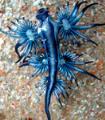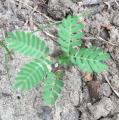
plant enthusiast
Posts: 93 Joined: 06-Mar-2013 Last visit: 17-May-2016 Location: planet earth
|
I recently was told by a herbologist I met that the native Florida ground mimosa is most definitely active. I used to have pics of the plant but I don't anymore unfortunately. However it is a vining species with thorns. He informed me that this species grows a carrot like tap root full of the goods.
Furthermore he says it is potent enough to put in your upper lip above your front most teeth and activity will start soon after. He claims one can take a strong enough DMT source in this sublingual manner and have activity maoi free. Can anyone back this claim? He says being absorbed from that area that DMT can bypass the digestive process altogether and enter the blood stream close enough to the brain to pass right through the barrier without being destroyed as if taken orally.
Now I suggest we as explorers and experimenters should attempt these avenues. Some Florida member could attempt to locate a plant and perform an extraction. Also if someone had a potent enough bark source could try the lip thing. He stated that M. tuniflora or hostilis is not strong enough to be taken this way unless an maoi was active in the body first and then the bark placed in the lip. I found this information intriguing enough to post this as I believe it to be true. I'm no idiot and this dude is the real deal. Knows more than I could hope to ever know about plants.
Another thing of interest he mentioned over time was that raw mace(the spice) is really high in 5 meo DMT content and that it is not well known outside a few people. He went on to state that mace is usually cured by sun drying and the process eliminates its potency. It must be raw and uncured. He says put a chunk of that in your lip and say your prayers.
What do you all here think of this? Another forum wasn't of much help or enthusiasm to pursue these ideals. I would not be opposed to attempting to procure a mimosa of the suspect species and send it to whom has time to extract it and report the data. I unfortunately don't have the means of extraction so I stick to natural teas for my experiments. Although the mighty DMT has not passed my brain yet. Only cacti and fungi so far even though I have growing some impressive DMT plant species I will share with you all in time.
|
|
|
|
|

DMT-Nexus member
Posts: 14191 Joined: 19-Feb-2008 Last visit: 22-Nov-2025 Location: Jungle
|
Can you tell us the scientific name of the plant please?
|
|
|

plant enthusiast
Posts: 93 Joined: 06-Mar-2013 Last visit: 17-May-2016 Location: planet earth
|
I will attempt to find it for you. Report back promptly if I can.
|
|
|

plant enthusiast
Posts: 93 Joined: 06-Mar-2013 Last visit: 17-May-2016 Location: planet earth
|
I believe the plant to be Mimosa strigillosa but that may not be correct. It is native to Florida and strigillosa is a Florida native fitting the description. I know where some of these are but I would have to trespass into a large yard with a dog. Not sure I can do that sadly. I will find one again though someday.
|
|
|

DMT-Nexus member
Posts: 163 Joined: 18-Jul-2011 Last visit: 02-Apr-2024
|
MAOs are also in the brain, so it's not just a matter of bypassing the gut if you want the effect to last for long... On the other hand, there are endogenous MAOIs in saliva....
This is intriguing, but if this herbologist is being truthful and accurate perhaps there's some other chemistry going on in the plant to allow this?
|
|
|

DMT-Nexus member
Posts: 3207 Joined: 19-Jul-2011 Last visit: 02-Jan-2023
|
wira wrote:MAOs are also in the brain, so it's not just a matter of bypassing the gut if you want the effect to last for long... On the other hand, there are endogenous MAOIs in saliva.... he clearly mentioned sublingual administration rather than oral Quote:He claims one can take a strong enough DMT source in this sublingual manner and have activity maoi free. Can anyone back this claim? He says being absorbed from that area that DMT can bypass the digestive process altogether and enter the blood stream close enough to the brain to pass right through the barrier without being destroyed as if taken orally. My wind instrument is the bong
CHANGA IN THE BONGA!
樹
|
|
|

DMT-Nexus member

Posts: 1711 Joined: 03-Oct-2011 Last visit: 20-Apr-2021
|
MadPlanter wrote:I believe the plant to be Mimosa strigillosa but that may not be correct. The stems of strigillosa are not prickly. If as you mentioned in your first post it's a vining species with thorns native to Florida, it might be M. Microphylla or M. Quadrivalvis. "The Menu is Not The Meal." - Alan Watts
|
|
|

DMT-Nexus member
Posts: 14 Joined: 01-Sep-2013 Last visit: 20-Nov-2016
|
Strigillosa does have bristles, rather than spines, and spreads like a groundcover, so it's kind of "viney"...I think it's still possible strigillosa may be the culprit. Cuttings are also sold by a reputable online entheo-vendor.
|
|
|

DMT - Not yet
Posts: 88 Joined: 07-Sep-2013 Last visit: 14-Nov-2019
|
This is a reLly cool topic, especially if finding out what you can extract from it.
|
|
|

DMT-Nexus member
Posts: 156 Joined: 25-Jul-2012 Last visit: 10-Oct-2023
|
I rarely post in this particular topic section, but something about this caught my eye. Has anyone else verified this? Is it in fact m. strigillosa or another genus? Isn't m. microphylla the one species of mimosa that when you touch it, it's leaves close up? IIRC, this species is inactive. I am really curious about this. Here are some pics I found of m. strigillosa and m. microphylla, shown in the same order listed. They look remarkably similar! Ancotar attached the following image(s):  424780.jpg (113kb) downloaded 466 time(s). Mimosa_microphylla_plant.jpg (93kb) downloaded 466 time(s)."We speak of Time and Mind, which do not easily yield to catagories. We separate past and future and find that Time is an amalgam of both. We separate good and evil and find that Mind is an amalgam of both. To understand, we must grasp the whole." -Isaac Asimov
"You will not be punished for your anger, you will be punished by your anger." -Buddha
"I must not fear. Fear is the mind killer. Fear is the little death that brings total obliteration. I will face my fear. I will permit it to pass over me and through me. And when my fear is gone I will turn and face fear's path, and only I will remain." -Paul Atreides, while being tested with the Gom Jabbar by the Reverend Mother Gaius Helen Mohiam
|
|
|
DMT-Nexus member
Posts: 6 Joined: 20-Jul-2012 Last visit: 06-Feb-2023 Location: Tampa
|
Thanks to Madplanter for posting this information... When I first read this post, I was very doubtful about the accuracy of the second hand information coming from the herbalist for at least two reasons. First, the most likely species here in Florida that fit that description are Mimosa quadrivalvis and M. strigillosa and neither of these have much record of medicinal use, except that quadrivalvis root was apparently used as an antidote to snake bites if more preferred roots were not available. Second, a root with such putatively high levels of tryptamine alkaloids would likely be associated with reports of toxicity from cattle grazing and I could find no record of such cases with these two species. Having said that, I did find pictures of vouchered specimens online for quadrivalvis here: http://www.florida.plant...etails.aspx?PlantID=3370And damned if these pictures below fit the description pretty well as "a vining species with thorns [that] grows a carrot like tap root" http://www.florida.plant.../specimens/USF/78788.jpghttp://www.florida.plant.../specimens/USF/41550.jpghttp://www.florida.plant.../specimens/USF/60358.jpgI plan to locate this plant soon and report back. Pictures of vouchered specimens online for M. strigillosa can be found here: http://www.florida.plant...etails.aspx?PlantID=2162While M. strigillosa less approximates the description from the herbalist in the OP, what I found very interesting was the unusual roots and stems from some of these specimens, which look almost mutated or infected with some sort of endotype (fungi perhaps?) which is not uncommon in the roots of nitrogen fixing plants. For example, compare these two pictures of M. strigillosa vouchered specimens. Normal http://www.florida.plant...specimens/USF/231683.jpgInfected with some sort of endotype? http://www.florida.plant...specimens/USF/278045.jpgThis reminds me of how ergot alkaloids found stored in morning glory seeds are actually synthesized by Clavicipitaceae fungi in a symbiotic relationship. See for example: http://www.ncbi.nlm.nih.gov/pubmed/25977213It makes me wonder whether the apparent variability of tryptamine levels within and across acacia and mimosa species might be accounted for by some similar, yet underappreciated, influence from bacterial or fungal endotypes associated with nitrogen fixation and/or root nodule development. I am also curious to know if anyone has had success growing tryptamine rich acacias or mimosas from seed in a locality not of its own origin. For example, someone having success growing an active acacia from Hawaii or Australia in a new location like Florida? I think this is an important question to answer because there seems to be other variables at play other than just plant genetics.
|
|
|

DMT-Nexus member
Posts: 257 Joined: 31-Dec-2009 Last visit: 25-Jan-2025 Location: outer limits
|
This is interesting, as the quadrivalvis looks like the mimosa growing all around the bayou I live by. They grow wild and plentiful and can be a nuisance. They grow a limbs distance apart and the roots are close to the surface, I could harvest a wagon load without hurting the mimosas. I will gets some pictures on my next walk. In all chaos there is a cosmos, in all disorder a secret order..Jung
All above writing with the exception of Dr. Jung's quote is pure mushroom encrusted cowpie!
|
|
|

DMT-Nexus member
Posts: 1129 Joined: 12-Jul-2014 Last visit: 18-May-2024 Location: on the world in time
|
I've made a brew before with m strigallosa. It could have been placebo I suppose, but I felt tryptamine effects. But with the amount I used it was fairly week. It grows everywhere here and I plan to do more work with plant when I have time. I think we'll end up finding dmt in more than one common plant or tree in North America at some point.
|
|
|

"No, seriously"

Posts: 7324 Joined: 18-Jan-2007 Last visit: 24-Nov-2025 Location: Orion Spur
|
BundleflowerPower wrote:I've made a brew before with m strigallosa. It could have been placebo I suppose, but I felt tryptamine effects. But with the amount I used it was fairly week. It grows everywhere here and I plan to do more work with plant when I have time. I think we'll end up finding dmt in more than one common plant or tree in North America at some point. I would advice to have a brew tested for content including toxic and poisonous properties before consuming any of it. We already saw this happening with grasses and it would sadden me if this happen again with the many Acacia species. So please stay responsible when you test these new sources. Kind regards, The Traveler
|
|
|

Hyperspace Cowboy
Posts: 380 Joined: 07-Jun-2015 Last visit: 30-Sep-2024 Location: The Nexus
|
From all the information I can find, and the description given by the OP's herbalist, I think m. Quadrivalvis best fits the description and from my research, it certainly appears to have the potential for endogenous DMT production. As for the sublingual absorption thing, I've found information which speculates the involvement of a tertiary amine called yuremamine, which is produced in various species of mimosa. A complex phytondole alkaloid which exists as an amaporhpous reddish solid when pure, it may actually be part of the deep red-purple colouring sen in jungle spice.They postulate that H bonding at the tertiary nitrogen may inhibit the metabolism of DMT. While not truly an MAOI unsure amine seems to have a synergistic effect which allows the oral capillaries to absorb DMT without it being metabolised by MAO, although the required dose is significantly higher (equivalent to 45g MHRB) which suggests that yuremamine may only partially inhibit the metabolism of DMT. Regardless of its secondary alkaloid content, I'm interested to see the results of tests done by some of our members. If it does indeed contain such high levels of DMT, as suggested by the mystery botanist, it could be a plentiful native source for our American members. "Laws alone can not secure freedom of expression; in order that every man present his views without penalty there must be a spirit of tolerance in the entire population." -Albert Einstein
I'm not a big fan of SWIM. I mean, I've never met the guy, but any time I hear about him, he's doing something sketchy.
|
|
|

DMT-Nexus member
Posts: 1129 Joined: 12-Jul-2014 Last visit: 18-May-2024 Location: on the world in time
|
The Traveler wrote:BundleflowerPower wrote:I've made a brew before with m strigallosa. It could have been placebo I suppose, but I felt tryptamine effects. But with the amount I used it was fairly week. It grows everywhere here and I plan to do more work with plant when I have time. I think we'll end up finding dmt in more than one common plant or tree in North America at some point. I would advice to have a brew tested for content including toxic and poisonous properties before consuming any of it. We already saw this happening with grasses and it would sadden me if this happen again with the many Acacia species. So please stay responsible when you test these new sources. Kind regards, The Traveler Any advise on how to go about that?
|
|
|

Hyperspace Cowboy
Posts: 380 Joined: 07-Jun-2015 Last visit: 30-Sep-2024 Location: The Nexus
|
Just do a crude methanol soak of some clean, dry root bark and take it to a local analytical lab for GC-MS testing. I'm assuming you live in the southeastern us, so there should be at least one reasonably close by. I can't speak to pricing if you were to walk in and want just one sample analysed. If you were to do that though, it would be a good idea to bring a comparative sample (eg a crude methanol extract of MHRB). Otherwise, I know there are some nexians out there with access to this type of equipment (endlessness instantly springs to mind, although benzyme could probably get this done too) who would likely be happy to test a sample if you were to ship it to them. "Laws alone can not secure freedom of expression; in order that every man present his views without penalty there must be a spirit of tolerance in the entire population." -Albert Einstein
I'm not a big fan of SWIM. I mean, I've never met the guy, but any time I hear about him, he's doing something sketchy.
|
|
|

DMT-Nexus member
Posts: 1129 Joined: 12-Jul-2014 Last visit: 18-May-2024 Location: on the world in time
|
Sorry I took so long to reply. I have some acrb for comparison, i may be going camping next week with a friend who loves research as well, awesome person in my book. Perhaps we can harvest some roots and do the methanol soaks, then figure the rest out after.
|
|
|

plant enthusiast
Posts: 93 Joined: 06-Mar-2013 Last visit: 17-May-2016 Location: planet earth
|
Hello folks! Sorry for the long term disappearance! Wanted to update this topic. I have located the plant again after four years! It is M. quadrivalvis. I have a buddy and member here who's soon gonna test this guy for us. In other good news though M. strigillosa from my yard tested positive recently. He wants to test it again though to be sure. Hopefully we'll know shortly!
Peace
|
|
|

DMT-Nexus member
Posts: 459 Joined: 13-Mar-2013 Last visit: 20-May-2020
|
Can't wait to hear, MadPlanter! Forge a Path with Heart <3
|